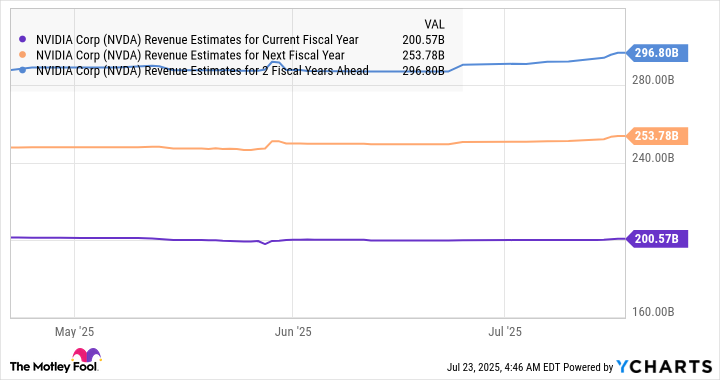An investment of just $1,000 in shares of Nvidia (NVDA +1.14%) five years ago is now worth $16,000 as of this writing. The stock's outstanding jump during this period is justified as Nvidia has delivered a remarkable increase in its revenue and earnings, thanks to artificial intelligence (AI).
Investors, however, may now be wondering if Nvidia can continue to remain a top growth stock over the next five years as well. After all, it is now the largest company in the world with a market cap of more than $4 trillion. This huge market cap makes it difficult for Nvidia to replicate its multibagger returns over the next five years, as a 16x jump in its share price would send its market cap beyond $64 trillion.

NASDAQ: NVDA
Key Data Points
The global economy is expected to be worth $144.5 trillion in 2028. So, Nvidia accounting for nearly 45% of the global gross domestic product (GDP) seems absurd as compared to its current share of around 3.5%.
However, don't be surprised to see Nvidia's market cap rise higher despite the stunning gains it has delivered in the past five years. Let's look at the potential upside this semiconductor giant could deliver by 2030.

Image source: Getty Images.
Nvidia's business still has a lot of room for growth
Analysts are expecting Nvidia to deliver $200 billion in revenue in the current fiscal year (which will end in January 2026). That would be an improvement of 53% from the previous fiscal year. This huge revenue base that Nvidia has already achieved explains why analysts are projecting a slowdown in Nvidia's revenue growth over the next couple of fiscal years.
NVDA Revenue Estimates for Current Fiscal Year data by YCharts
But then, analysts are probably overlooking the huge opportunity in data centers that could help Nvidia easily exceed expectations. A lot of money is set to be spent on data centers through 2030 to support both AI and non-AI workloads. Consulting firm McKinsey is forecasting total spending of $6.7 trillion on data center infrastructure through 2030, with three-fourths of that expected to be spent on AI-specific workloads.
Again, of the $5.2 trillion that's projected to be allocated toward AI-focused data center spending, $3.1 trillion will go toward "technology developers and designers, which produce chips and computing hardware for data centers," as per McKinsey. Nvidia's leadership position in the AI chip market means that it is in a solid position to capitalize on this huge end-market opportunity going forward.
According to one estimate, GPUs accounted for almost 60% of the overall AI accelerator market last year. Assuming that the share of GPUs falls to even 40% in 2030 thanks to the rising popularity of custom AI accelerators, they could still account for more than $1.2 trillion in revenue. Nvidia controlled 92% of the AI GPU market last year.
AMD is its closest competitor in this market, but its data center GPU revenue is nowhere near Nvidia's. Of course, AMD's product development moves could help it close the technology gap with Nvidia, but the latter enjoys an advantage on the supply chain front.
Reports suggest that Nvidia's foundry partner TSMC has allocated 70% of its advanced chip packaging capacity to the former for 2025. That's a big deal, as advanced packaging is key to the production of AI chip platforms. As such, the possibility of Nvidia losing control over the supply chain and the AI chip market seems a bit difficult.
The chip designer has a net cash position of more than $43 billion at its disposal. This allows Nvidia to secure a large part of the AI supply chain for itself when we consider that AMD doesn't have even 10% of that amount at its disposal. As such, Nvidia can continue to control a big share of the AI chip market over the next five years, and that's likely to translate into healthy upside.
How much upside can investors expect?
Though Nvidia towers above its competitors in AI chips, we are going to assume that its market share falls to 50% in AI GPUs after five years. Even if that's the case, the company's data center revenue could hit $600 billion (based on the $1.2 trillion estimate of the AI GPU market in 2030 calculated earlier).
The data center business produced 88% of Nvidia's revenue in the first quarter of the current fiscal year. If Nvidia indeed clocks $200 billion in revenue in the ongoing fiscal year and the data center segment accounts for 88% of that, its revenue from data centers could hit almost $180 billion. So, Nvidia's data center revenue could grow by more than 3x in the next five years to $600 billion (as we estimated in the previous paragraph).
If the company doesn't get any revenue from its other segments and solely relies on data centers after five years, it could still deliver healthy stock price gains. Nvidia has a five-year average sales multiple of almost 24. If it trades at half of that multiple after five years, its market cap could jump to $7.2 trillion based on the $600 billion revenue estimate.
That would be an 80% increase from current levels, which means that investors can still consider buying this AI stock as it seems built for more upside over the next five years.






